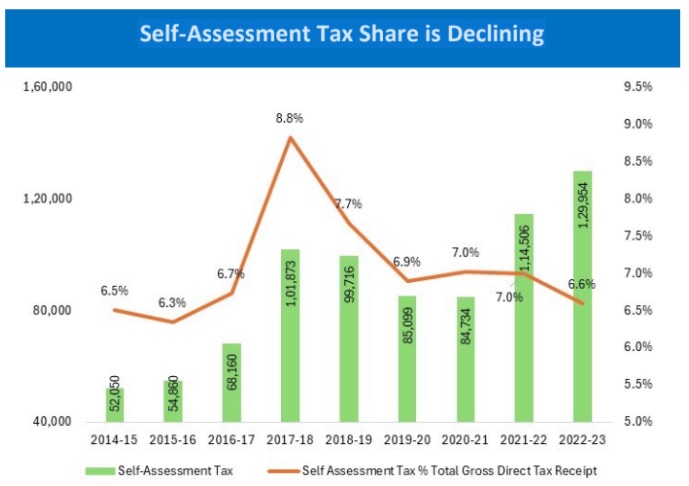Though, transactions through cheque has been declined significantly and remained stagnant within Rs65-70 lakh crore during the last 3-years but Continuous Clearing of Cheques under Cheque Truncation System (CTS) will help customers in releasing their value quickly.


FinTech BizNews Service
Mumbai, August 11, 2024: The State Bank of India’s Economic Research Department has come out a research report. The report has been authored by Dr. Soumya Kanti Ghosh, Group Chief Economic Adviser, State Bank of India.
Highlights from the report:
The RBI MPC, reaching its half a century mark in an eventful stride since 2016, delivered the rate based outcomes along expected lines (and, with expected majority of 4-2) while the tone and pitch signalled the near optimal factoring of clouds gathering on multiple fronts despite domestic macros continuing a robust forward march; an intense monsoon locally with uneven spatial distribution that can dismantle the maths behind food price led inflation and its interlinkage with households expectations, challenging outlook on merchandise trade as the largest economy signals a cooling off phase, smooth transmission of yields and premiums across various terms and products against ever changing landscape of liquidity. The need for synchronising stance, facilitating actual rate pivot thus assume greater significance in uber uncertain times.
The emphasis of the governor, even when the fragmented MPC pledged support to keep the policy rates unchanged ninth times in a row in line with broader market expectations, remained on the skewed probability of downside risks gaining currency, dismantling the present equilibrium where risks appear evenly balanced and growth remains resilient, factoring in the choppiness prevailing in global markets. The rise of frenzied calls for the Fed to take a significant pivot, either through an off-cycle rate cut or slashing Federal Funds rate by as much as 50 bps in its ensuing Sept meet, is gaining currency as the largest economy stares at an imminent recession with the trigger of Sahm Rule being seen more of a leading indicator this time, aggravating the pain points as the lopsided jobs markets (full time as also part time), and spike in joblessness across whites and Asian sub-groups too, at vantage traditionally against Hispanics and people of color point to a rapidly cooling economic progression, having a ripple effect across global markets. This limits fiscal flexibility and further increases economic uncertainty as carry trades are greatly being unleveraged, the sell-off in risky assets nudging a vicious cycle to take-off.
The instability could prime other Central Banks too, with ensuing ECB meet in September dubbed ‘wide open’ by market watchers for a rate cut while the house of BoE delivered the first rate cut in four years last week, departing from a 16-years high rate through a 5-4 vote, though vouching to move ahead cautiously. BoJ, that unnerved the markets last week through whiplashing currency traders, by hiking its policy rate to around 0.25% from a range of 0 to 0.1% is busy assuring the investors now of no imminent rate hikes. To cut a long story short, the choices before most of the Central Banks suddenly appear between choosing a fire, or a frying pan, with a hurried action with little communication likely to fan more panic to markets / investors.
By addressing the likelihood of building up of risks in the system from different known-unknown quarters, the regulator has sent a clear and present message to faltering entities to bring their houses in order. While hailing the fall in unsecured credit flows through NBFCs / Credit Card issuers, often boosting want-centric consumption amidst different cohorts of lower strata, the regulator has also warned of excessive focus on top-up loans attached to otherwise secured loans viz. housing / gold which are eventually finding ways in speculative purposes. Plus, the concerns on stable, retail led deposit accretion to banks should nudge the stakeholders ramping up the efforts to reward the average depositors through efficient and effective mechanisms, including tax efficacy. The first piece of the jigsaw puzzle, though should ideally be to analyze the flows of household savings to myriad available avenues/channels.
In line with its concerns on rising household indebtedness in lower income deciles, the regulator has also shifted its action to online digital lending apps (DLA). With a view to provide information and differentiate between genuine lending apps and otherwise cohorts, RBI has decided to create a public repository of DLAs deployed by the REs which will be available on RBI’s website. It is expected that this measure will put some check on the digitalized loan shark business. RBI has also decided to alter the frequency of reporting to credit information companies (CICs). The altered frequency which is shortened from the present 30 days to 15-days is expected to give more up-to-date picture of a borrower’s indebtedness. Plus, borrowers will have the benefit of faster updation of information while lenders will be able to make better risk assessment of borrowers and also reduce the risk of overleveraging by borrowers.
On the payments side, the present policy enhances the limit of UPI based payment of taxes from Rs 1 lakh to Rs 5 lakh (limits were earlier increased too for other eligible purposes in Dec 21 and Dec 23). Self-Assessment tax constitutes around 7% of the total gross direct receipt. By easing the limit, transactions through UPI will get a boost in alternate uses too. Furthermore, it is proposed to introduce "Delegated Payments" in UPI. “Delegated Payments” would allow an individual (primary user) to set a UPI transaction limit for another individual (secondary user) on the primary user’s bank account. This allows the primary user to authorise another individual to make UPI transactions from its own bank account. RBI also proposed to transition CTS from the current approach of batch processing to continuous clearing with 'on-realization’ settlement, reducing from the present T+1 days to a few hours, helping customers in releasing their value quickly even as the cheque settlements stagnate.
The expectation of normal monsoon and healthy kharif sowing will support improving rural demand. This along-with sustained momentum in manufacturing and
services activity may enable a revival in private consumption. However, the bright outlook may be clouded with geopolitical tensions, volatility in international commodity prices and geo-economic fragmentation.
RBI has been actively managing liquidity through main and fine-tuning operations and has ensured that liquidity remains adequate. The impending JIT mechanism that keeps Government cash balances out of Banking system could have an impact on liquidity going forward. Furthermore, capital flows in FY25 could pose challenges and opportunities for RBI liquidity management. We believe that temporary liquidity
injections should replace temporary liquidity withdrawals, thus OMO cannot be a tool to counterbalance idiosyncrasies in Government cash balances and only VRRR can replace it.
RBI thus needs to innovate on liquidity management.
RBI has decided creating a public repository of DLAs deployed by the REs which will be available on RBI’s website. It is expected that this measure will put some check on the digitalisation loan shark business.
RBI has proposed to increase the UPI limit for tax payments from Rs 1 lakh to Rs 5 lakh. The hike in the limit will help the taxpayers to pay higher tax liability quickly. The payments made via UPI usually do not attract any additional charges.
This is not the case when tax payments are made via debit and credit cards.
• This is not the first time that the RBI has hiked the limit. In December 2023, the central bank hiked the limit to Rs 5 lakh from certain payments, such as hospital and educational institutions. In December 2021, the transaction limit for UPI payments for Retail Direct Scheme and IPO subscriptions was increased to Rs 5 lakh.
• Self-Assessment tax is around 7% of the total gross direct receipt. By easing the limit, transactions through UPI will definitely increase.
• Introduction of Delegated Payments through UPI: RBI has also announced introduction of delegated payments via UPI, which would allow an individual to set a UPI transaction limit for another individual on the primary user’s bank account. This is likely to mean that an individual will be able to provide access to his bank account for UPI payments to another individual say (family member). This is in line with the Add-on card facilities provided by the credit card companies and expected to add to the reach and usage of digital payments across the country.
• Continuous Clearing of Cheques under Cheque Truncation System (CTS): RBI proposed to transition CTS from the current approach of batch processing to continuous clearing with 'on-realisation-settlement, which will reduce from the present T+1 days to a few hours.
• Though, transactions through cheque has been declined significantly and remained stagnant within RS 65-70 lakh crore during the last 3-years but this step will help customers in releasing their value quickly.